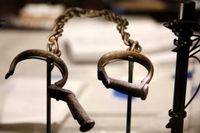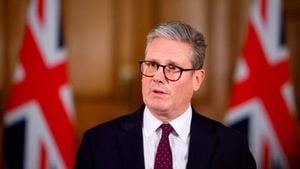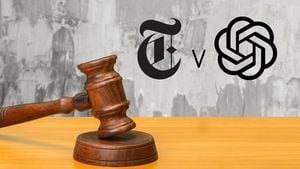On the eve of a pivotal deadline, the Smithsonian Institution finds itself at the heart of a heated national debate over museum independence, government oversight, and the very narratives that shape American identity. By Friday, September 12, 2025, the Smithsonian was required to submit a broad array of internal materials to the White House as part of a review ordered by President Donald Trump’s administration—an unprecedented move that has sent ripples through the museum world and beyond, according to CNN.
The White House’s directive, delivered in August, demanded everything from gallery wall labels and future exhibition plans to internal communications about artwork selection. This is the first of three deadlines in a sweeping review that will scrutinize the Smithsonian’s programming, especially as the institution prepares for the country’s 250th birthday celebration next July. The review is part of a larger effort by the Trump administration to align the nation’s leading cultural institutions with its own vision of American heritage, focusing on rooting out what it labels “progressive” or “woke” ideology and anti-American propaganda.
“The Smithsonian is not an autonomous institution, as 70% of its funding comes from taxpayers,” said Lindsey Galligan, a Trump aide spearheading the review, in comments to CNN. She added, “The American taxpayers deserve nothing less, which is why the White House will ensure an impartial audit.” The review is, in Galligan’s words, “non-negotiable.”
The Smithsonian, a unique public-private trust, does not consider itself an executive agency. Yet, with two-thirds of its billion-dollar budget funded by the federal government, it has never been immune to political pressure. Still, this level of direct White House involvement in curatorial decisions is without precedent. The institution’s director, Lonnie Bunch III, is now walking a tightrope—balancing a working relationship with the White House while defending the Smithsonian’s independence. Multiple sources told CNN that Bunch appears to be “holding the line as much as he can,” even as members of the Board of Regents, which governs the institution, urge him to assert its autonomy.
Leadership at the National Museum of African American History and Culture (NMAAHC), which has faced particular scrutiny from the administration for its focus on the legacy of slavery, told staff earlier this year that programming is not expected to shift despite the executive order. But the climate of heightened oversight is already influencing decisions. According to CNN, in July, artist Amy Sherald canceled a major exhibition at the Smithsonian after a dispute over the contextualization of her painting depicting the Statue of Liberty modeled after a transgender artist. The Smithsonian denied any censorship, stating it had merely requested a video to provide context for the work.
Controversy also erupted around the symposium for the exhibition “The Shape of Power.” Initially planned as a public event, it was changed to invitation-only, with a request for no social media or recording. Two artists, including Nicholas Galanin, withdrew in protest. Galanin told CNN, “I cannot participate in the symposium and remain in alignment with my moral convictions. The decision to make the symposium a private event with a curated guest list and request that we not record or share it on social media effectively censors those of us who would be participating.” The Smithsonian responded that the event was always intended to be by invitation and that the decision not to record was out of respect for participants’ privacy.
Other artists have voiced similar concerns. Sasa Aakil, a poet and artist, told CNN that some of her and her colleagues’ poems were cut from a May event at NMAAHC commemorating Malcolm X. She said organizers cited increased White House scrutiny as the reason for the cuts. The Smithsonian did not respond to a request for comment on this incident.
Institutional changes have also followed the administration’s directives. In January, the Smithsonian eliminated its Office of Diversity after President Trump issued an executive order threatening federal investigations into what he called “illegal DEI” (diversity, equity, and inclusion) initiatives. By March, another executive order targeted “improper ideology” at the Smithsonian, putting Vice President JD Vance in charge of ensuring that government spending on exhibits aligns with the administration’s agenda.
President Trump himself has been vocal about his dissatisfaction with certain Smithsonian exhibitions, particularly those he believes focus too heavily on America’s shortcomings. In a recent social media post, Trump claimed, “Everything discussed is how horrible our Country is, how bad Slavery was, and how unaccomplished the downtrodden have been—Nothing about Success, nothing about Brightness, nothing about the Future.” Yet, he also praised the institution for making “big changes,” noting that previous administrations had also influenced the Smithsonian’s direction.
The administration’s review is set to culminate in early 2026, with the White House expecting the Smithsonian to implement any “corrections” to its content by December. However, it remains unclear what enforcement mechanisms, if any, the White House could employ if the Smithsonian resists changes.
This high-stakes standoff has drawn the attention of lawmakers. Michigan Senator Gary Peters, a Democrat and member of the Board of Regents, told CNN that Bunch is doing “a very good job” and insisted the Smithsonian “goes out of its way” to ensure its exhibits are free of bias. In a letter last week, Peters, Senator Catherine Cortez Masto, and two other Senate Democrats urged Bunch to safeguard the institution’s independence and requested that any materials shared with the White House also be provided to Congress. House Democrats have echoed this support, with Representative Joe Morelle stating that Bunch and Smithsonian experts “objectively and accurately tell the American story.”
Meanwhile, the composition of the Smithsonian’s Board of Regents could soon shift. Six of the nine general public regents’ terms end in 2026, and new appointments require both congressional approval and the president’s signature—potentially giving Trump further influence over the institution’s future direction before the midterm elections. The board also includes six members of Congress, public regents, Vice President Vance as an ex officio member, and Chief Justice John Roberts as its head.
Lonnie Bunch, a respected historian and founding director of the NMAAHC, is no stranger to political turbulence. In his 2019 memoir, he warned that the “Smithsonian could easily become a pawn in larger political debates.” He recounted Trump’s first visit to the NMAAHC in 2017, when the president praised the museum for its portrayal of “the great struggle for freedom and equality that prevailed against the sins of slavery and the injustice of discrimination.”
But times have changed. As the Smithsonian faces mounting pressure to conform to the administration’s cultural agenda, the institution’s leaders, staff, and supporters are left to grapple with a fundamental question: Who gets to decide how America’s story is told?
For now, the Smithsonian’s fate hangs in the balance, poised between its storied tradition of independent scholarship and the shifting winds of political power.




